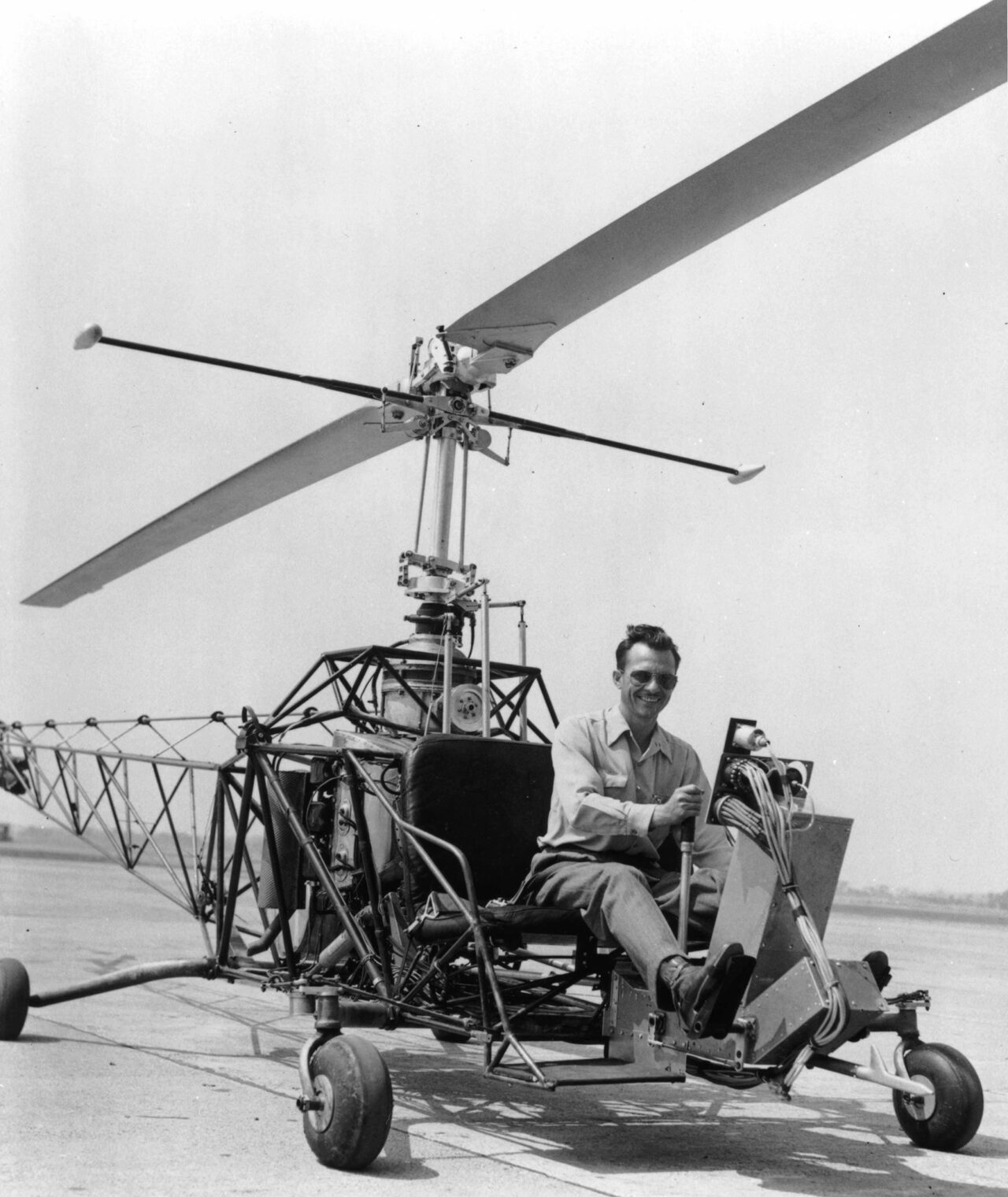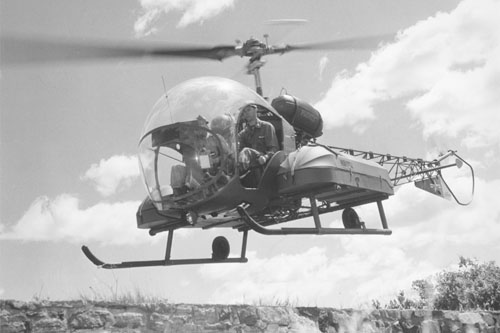The Bell 47 – The first successful helicopter
It was the military, both in Germany and the USA that, thanks to their interest and financial support resulted in the helicopter graduating from an experimental vehicle to a functional and useful machine. But Sikorsky was not the only one to be experimenting with helicopters in the United States. In 1941 designer Arthur M. Young contacted aircraft manufacturing company the Bell Aircraft Corporation with a proposal. Young had independently been experimenting with helicopters in the form of scale models, and put forward a proposal for a full scale version. Bell agreed to build a number of prototypes and so Young started to work for the company. In the shadow of war the Bell 30 appeared and was tested. The third prototype laid the foundation for the Bell 47.

An early prototype of what would become the Bell 47. Photograph: Niagara Aerospace museum
In December 1945 the Bell 47 made its maiden flight, and a few months later, in March 1946 it was the first helicopter in the world to be approved for civilian use. Whilst Sikorsky’s R4 only flew for the military, the Bell 47 became the type of helicopter that made its mark on a broad front. The first delivery of a civilian Bell 47 took place on December 31, 1946 to a company called Helicopter Air Transport, which was the first ever civilian helicopter operating company, and had been founded the previous year. They already used several Sikorsky helicopters that now faced competition from Bell’s product.
The design of the cockpit varied between the early versions, but in 1953 appeared what would become the most common model, the Bell 47G with the now classis “soap bubble” canopy, as Arthur M. Young himself called it.
The American military forces had also noticed the new helicopter, and both the Air Force and the Navy ordered the Bell 47 with the designation H-13 Sioux in 1947. The next year the US Army followed suit and ordered its first examples.
The Korean War – From a nobody to a celebrity
In 1950 North Korean forces invaded South Korea with the intention of uniting Korea to form a single country. North Korea was fully equipped with well-tried Soviet equipment in the form of artillery, tanks and aircraft. The South Korea army was forced further and further back. The United Nations then decided to permit member countries to send forces to aid South Korea, with the USA being the main participant. Under American leadership the North Korean offensive could finally be forced back, but just when it appeared that the UN forces were about to achieve total victory, the China intervened and sent large forces to the aid of North Korea. The now Communist China did not want to see its neighbour, also Communist North Korea, conquered. Even the Soviet Union would covertly send such help as fighter pilots in the new MiG-15 fighter aircraft to North Korea and China to help. This led to the Korean War becoming the first conflict where jet aircraft met other jet aircraft in battle. However it was also a war in which the helicopter made its major breakthrough. The various branches of the American military employed helicopters in many non-combatant roles. Search and Rescue was one area in which the helicopter provided important possibilities. Pilots who crashed, even behind enemy lines, could now be rescued relatively quickly if a helicopter could reach the area. This was a major change from the Second World War, in which shot down pilots had to find their own way back in most cases and often ended up as prisoners of war.
Since a fighter pilot represented a large investment in training it was a bonus if they could be rescued. It takes a long time to replace an experienced pilot, and one of the lessons learned from the Second World War was how valuable experienced pilots were, both as effective combatants and leaders, inspiring others in their units. They also helped to train new pilots. The German Air Force, known as the Luftwaffe, lost much of its efficiency as its most experienced pilots were killed, captured or were wounded. The Allies rotated many experienced and skilled pilots back to flying training schools as instructors, in order to take advantage of their knowledge and experience, which in the long run gave good results, while the Luftwaffe kept its flying aces in the front line as long as possible. Those shot down over enemy territory were lost to combat, even if they physically survived.
Being able to send in a helicopter to fetch back a pilot who could then return to the air in a new aircraft was a major development that also served to heighten morale among aircrew. A similar role was also adopted by the helicopters that performed what is today called MEDEVAC (Medical Evacuation), that is to say collecting and returning casualties from behind or near to the front line away to a field hospital, or transferring them from small to large hospitals in the rear areas.

A Bell 47 approaching with two stretchers, one each side: Photograph US Air Force
The Bell 47/Bell H-13 Sioux now took up the role as not only life-savers for valuable fighter pilots, but also for soldiers in the field. Some studies have shown that soldiers in battle are often more afraid of being wounded than for being killed outright. Partly the fear of being permanent invalids for the rest of their lives, and also of suffering a long and painful death. Seeing injured comrades die without being able to help them also lowers morale among soldiers. Knowing that a wounded fellow soldier can be flown away to a hospital manned by skilled care personnel is important in maintaining the courage of each individual soldier.
The classic American TV series M.A.S.H. played out during the Korean War was all about such a field hospital, and the introduction to each episode was dominated by two Bell-47Gs arriving with stretchers each side of their cabins. This was not a question of especially complex transport. The wounded were placed on the stretchers, one each side of the helicopter, wrapped up and strapped in. A cover at the front end provided some protection against the wind as they flew forward. Nevertheless, even this primitive mode of transport was a huge step forward in military patient care. Now, even the severely injured could despite their condition be saved and if they received rapid surgical treatment be flown out instead of being shaken about on a stretcher being carried by their comrades or on a vehicle subjected to rocky or uneven ground.
The War allowed the Bell 47 to show what it was good for, and it was even employed in a civilian role for the same purposes, as a police helicopter, for transportation and also as a means of conveying important and/or rich people. It would also be the first TV helicopter to carry camera crews directly to the scene of the action. It was the KTLA television station in Los Angeles, California, that started this off when it hired a Bell 47 and named it the “Telecopter”. The inventor of this concept was one John D. Silva who equipped with a TV camera took off in the “Telecopter” for the first time on July 3rd, 1958. All went well until the station called the crew and told them that no pictures had been received! In what can be described as an extremely daring move, Da Silva climbed out on to the landing skid while the helicopter hovered at a height of 450 metres (1,500 feet). He was able to find the fault in the transmitter, and could repair it the next day. On the 4th of July the Telecopter took off again and this time the technology worked as it should, so that the world’s first TV transmission from a helicopter took place.
The Bell 47 even had a role in the training of the astronauts who would control the moon lander in the Apollo programme. Also this model was for many years used by many countries for basic helicopter training. It was even built under licence in Italy and Japan, with a total of more than 5,600 constructed between 1946 and 1974.
Sikorsky may have developed the modern helicopter, but it was Arthur M. Young who created the first commercially successful helicopter, and that with a vengeance. There are still many Bell 47s flying all over the world, even though it is now 75 years since the first one flew. This is despite the fact that the first helicopters, with their small piston engines were outclassed in performance by newer machines with turbine engines already in the 1950s.
However the Bell 47 has shown itself to be a stubborn survivor and a classic.
